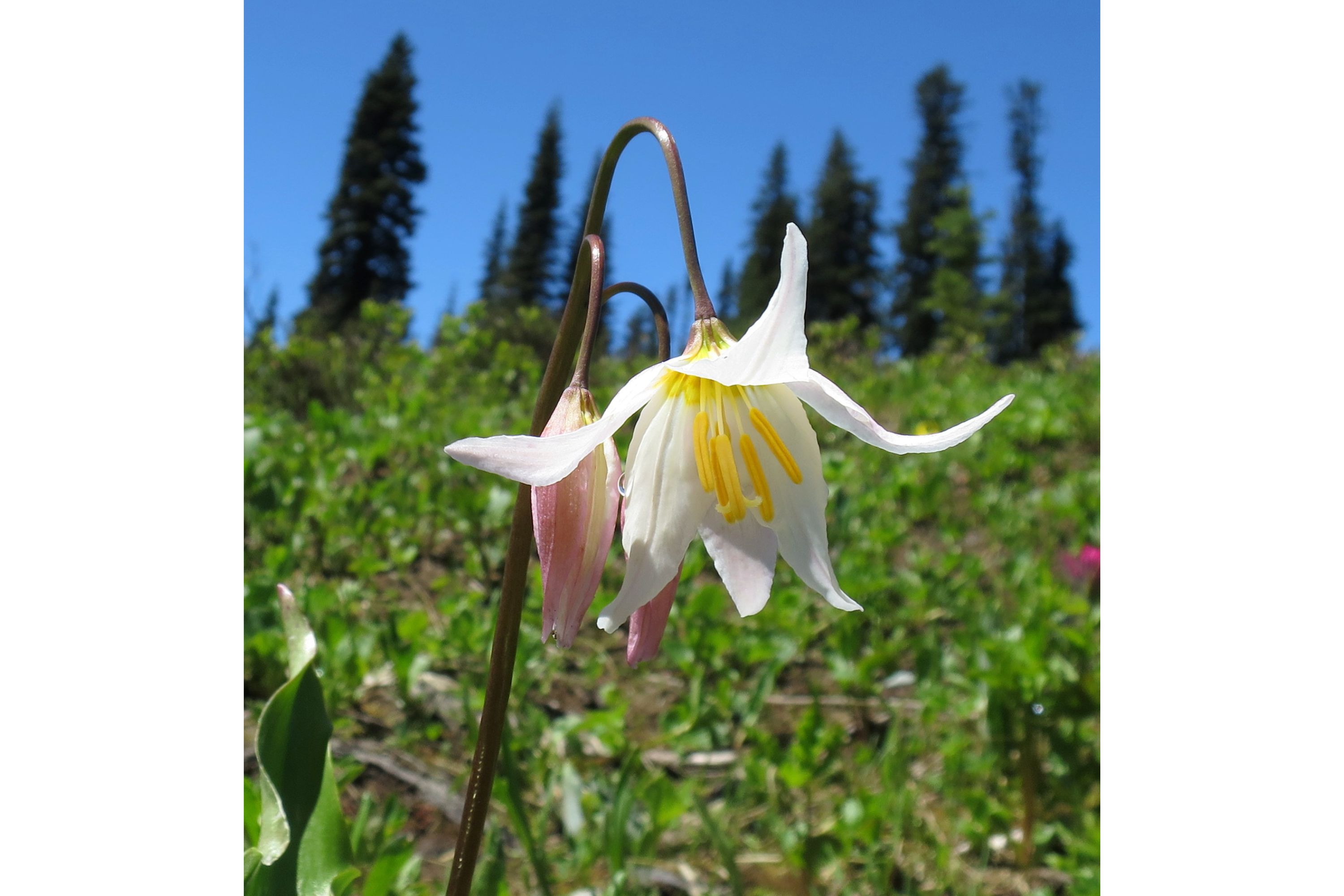Avalanche lily
(Erythronium montanum)

Description
Erythronium montanum, commonly known as the avalanche lily, is a perennial herbaceous plant species belonging to the family Liliaceae. It is native to western North America and is commonly found growing in open meadows, slopes, and forests in high elevations, especially in mountainous regions. Description and morphology Erythronium montanum typically grows up to 10-20 cm in height and has basal leaves that are long and narrow, measuring up to 15 cm in length and 2 cm in width. The leaves are smooth and have a wavy margin. The plant produces one or two flowering stems, each bearing one to three flowers. The flowers are showy, measuring 2-3 cm in length and have six tepals that are white, pink, or lavender in color with yellow bases. The flower's six stamens are typically longer than the tepals. Distribution and habitat Erythronium montanum is native to western North America and is found in Alaska, British Columbia, Washington, Oregon, California, Montana, and Idaho. It is commonly found growing in open meadows, slopes, and forests in high elevations, especially in mountainous regions. In its native range, it is often one of the first plants to flower in the spring, emerging from beneath the snowpack. Ecology Erythronium montanum is an important plant species for pollinators and is visited by a variety of bees and butterflies. It is also an important food source for many mammals, including deer and elk, which feed on its leaves and bulbs. However, it is threatened by habitat loss due to human activities such as logging, grazing, and development. In some areas, it is also threatened by invasive species such as cheatgrass (Bromus tectorum). Cultivation Erythronium montanum is a popular ornamental plant that is cultivated in gardens and parks. It is relatively easy to grow and prefers well-draining soil and partial to full shade. The following are some tips for successfully cultivating Erythronium montanum: Soil: Erythronium montanum prefers well-draining soil that is rich in organic matter. The soil should be slightly acidic, with a pH between 5.5 and 6.5. Light: The plant prefers partial to full shade and is often found growing in forested areas. It is important to protect the plant from direct sunlight, which can scorch its leaves. Watering: Erythronium montanum prefers evenly moist soil but is susceptible to rot if the soil is too wet. Water the plant deeply but infrequently, allowing the soil to dry out slightly between watering. Fertilizer: Erythronium montanum does not require a lot of fertilizer, but you can apply a slow-release organic fertilizer in the spring to encourage healthy growth. Propagation: Erythronium montanum can be propagated by seed or by dividing its bulbs. Bulb division should be done in the fall when the plant is dormant. Gently lift the bulbs from the soil and separate the offsets, replanting them at a depth of 3-4 inches. In general, Erythronium montanum is a low-maintenance plant that is well-suited to gardens and woodland areas. It is important to note that wild plants should never be dug up and transplanted, as this can harm the plant population and ecosystem. Instead, obtain bulbs from reputable sources for cultivation. Uses Erythronium montanum is commonly cultivated as an ornamental plant in gardens and parks. It is prized for its showy flowers and is often used in rock gardens or naturalized in woodland areas. The plant prefers well-draining soil and partial to full shade. It is propagated by seed or by dividing its bulbs. The bulbs of Erythronium montanum are edible and were traditionally harvested and eaten by Native American tribes. However, it is important to note that wild plants should never be harvested without proper knowledge and permission, as overharvesting can have negative impacts on the plant population and ecosystem. In general, it is recommended to obtain bulbs from reputable sources for consumption. Conservation Status The conservation status of Erythronium montanum varies depending on the region and jurisdiction. In some areas, such as Oregon and Washington, it is considered a species of conservation concern and is listed as sensitive or threatened. In other areas, such as Alaska and British Columbia, it is more common and not considered at risk. The plant is threatened by habitat loss due to human activities such as logging, grazing, and development. In some areas, it is also threatened by invasive species such as cheatgrass (Bromus tectorum). It is important to protect and conserve natural populations of Erythronium montanum and to avoid overharvesting bulbs or disturbing wild populations. Conclusion Erythronium montanum is a beautiful and ecologically important plant species native to western North America. It is threatened by habitat loss and invasive species and is therefore considered a species of conservation concern in some areas. It is an excellent choice for cultivation in gardens and parks and is valued for its showy flowers and as a source of food for pollinators and wildlife.
Taxonomic tree:







